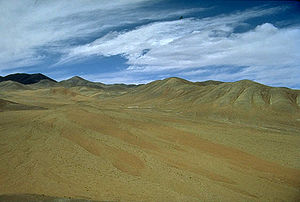Difference between revisions of "Atacama Desert" - New World Encyclopedia
John Willis (talk | contribs) (preliminary editing) |
John Willis (talk | contribs) (removed top category temporarily) |
||
| Line 1: | Line 1: | ||
[[Category:Deserts]] | [[Category:Deserts]] | ||
| − | + | ||
[[Image:Atacama1.jpg|300px|right|thumb|Atacama]] | [[Image:Atacama1.jpg|300px|right|thumb|Atacama]] | ||
Revision as of 04:47, 27 December 2005
The Atacama desert of Chile and Peru is a virtually rainless plateau made up of salt basins (salares), sand, and lava flows, extending from the Andes mountains to the Pacific Ocean.
The average width (east-and-west) is less than 160 kilometers (100 miles) but it extends from the Peruvian border 1,000 kilometers (600 miles) south to the Bolivian Altiplano. The mountains nearest to the ocean are the Pacific coastal range, with an average elevation of 800 meters (2500 feet). The Cordillera Domeyko, a range of foothills of the Andes Mountains, lies east.
The Atacama Desert is the driest desert on Earth (except perhaps for the McMurdo Dry Valleys in Antarctica) and is virtually sterile because it is blocked from moisture on both sides by the Andes mountains and by coastal mountains. The average rainfall in Antofagasta — a region in Chile which is part of the Atacama — is just 3mm per year, and there was a period of time when no rain fell there for 40 years. The Atacama is 15 million years old and 50 times more arid than California's Death Valley. It is so arid, in fact, that mountains that reach as high as 6,885 m (22,590 feet) are completely free of glaciers and in the southern part from 25°S to 27°S have possibly been throughout the Quaternary, though permafrost extends down to 4,400 m and is continuous above 5,600 m. The Atacama north of 25°S is arid and receives very little rain. However, many locations in the desert receive marine fog providing sufficient moisture for hypolithic algae, lichens and even cacti. In the region south of Antofagasta, though, the coastal range blocks the marine fog. The crest-line of the coastal range averages 3,000 m for about 100 km south of Antofagasta. The driest part of the Atacama is between the coastal mountains and the Cordillera Domeyko, an area called the 'double rain shadow.' In this region the Andes block moisture from the east, the Cordillera Domeyko block runoff from the Andes and the Coastal mountains block marine fog from the ocean. The region that is in the "fog shadow" of this high coastal crest-line is the region that contains the driest soils — the soils that have been compared to Mars.
In 2003 a team of researchers published a report in Science magazine titled "Mars-like Soils in the Atacama Desert, Chile, and the Dry Limit of Microbial Life" in which they duplicated the tests used by the Viking 1 and Viking 2 Mars landers to detect life, and were unable to detect any signs in Atacama Desert soil. The region may be unique on Earth in this regard and is being used by NASA to test instruments for future Mars missions. Alonso de Ercilla characterized it in La Araucana, published in 1569: "Towards Atacama, near the deserted coast, you see a land without men, where there is not a bird, not a beast, nor a tree, nor any vegetation" (quoted Braudel 1984 p 388).
The Atacama has rich deposits of copper and other minerals, and the world's largest natural supply of sodium nitrate, which was mined on a large scale until the early 1940s. The Atacama border dispute between Chile and Bolivia began in the 1800s over these resources.
The Atacama is inhabited, though sparsely populated. The Pan-American Highway runs through the Atacama. In an oasis, in the middle of the desert, at an altitude of some 2000 meters, is the village of San Pedro de Atacama. Its church was built by the Spanish in 1577, but archeological evidence indicates that the San Pedro area was the center of a Paleolithic civilization that built rock fortresses on the steep mountains encircling the valley. The Escondida Mine and Chuquicamata are also located within the Atacama.
The European Southern Observatory operates two major observatories in the Atacama desert:
- The La Silla Observatory
- The Paranal Observatory, which includes the Very Large Telescope.
External links
- news article on "Mars-like Soils in the Atacama Desert, Chile, and the Dry Limit of Microbial Life"
- National Geographic feature about Atacama
- Autonomous Robot Finds Life in Atacama Desert
- Atacama's Super-Dry History
Credits
New World Encyclopedia writers and editors rewrote and completed the Wikipedia article in accordance with New World Encyclopedia standards. This article abides by terms of the Creative Commons CC-by-sa 3.0 License (CC-by-sa), which may be used and disseminated with proper attribution. Credit is due under the terms of this license that can reference both the New World Encyclopedia contributors and the selfless volunteer contributors of the Wikimedia Foundation. To cite this article click here for a list of acceptable citing formats.The history of earlier contributions by wikipedians is accessible to researchers here:
The history of this article since it was imported to New World Encyclopedia:
Note: Some restrictions may apply to use of individual images which are separately licensed.
